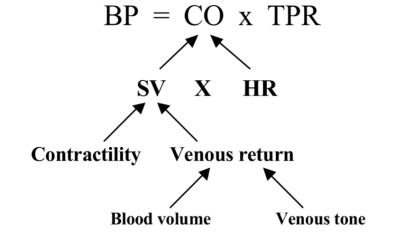Autonomic Nervous System Effects Primer
Parasympathetic
Eyes
Pupils constrict, improving near vision.
Glands
Increase in secretions (lacrimal, nasal, and salivary).
Bronchi
Increase in secretions and constriction of smooth muscle.
Heart
Vagal nerve tone results decreased heart rate (via sinoatrial node). Conduction through the AV node decreases and atrial contractility lowers.
Gastrointestinal/Urinary
Promotion of digestion and urination. Increased gastric acid secretion in the stomach, motility of smooth muscles, and relaxation of sphincters. Contraction of bladder.
Sympathetic
Eyes
Pupils dilate, allowing in more diffuse light.
Bronchi
Dilation and relaxation of smooth muscle.
Heart
Increase in heart rate (via sinoatrial node). Conduction through AV node increases and contractility for atria and ventricles increases.
Release of epinephrine (from adrenal medulla) leads to dilation of blood vessels and increases liver blood volume.
Gastrointestinal/Urinary
Downregulation of digestion and urination. Decreased gastric acid secretion in the stomach, lowered motility of smooth muscles, and constriction of sphincters. Contraction of bladder.
Kidney
Increased renin → increased sodium retention → increased water retention
Increased glycogen breakdown, glucose release
Skin
Piloerection and sweating.
Adrenergic Receptor Functions
| Location | Activation | Response | |
|---|---|---|---|
| Alpha | Smooth muscle, pupillary muscle, skin follicles, GI/bladder | Epinephrine and norepinephrine | Vasoconstriction, pupil dilation (mydriasis), piloerection, sphincter contraction |
| Beta-1 | Heart/kidney | Epinephrine and norepinephrine | Increased: Heart rate, AV node conduction, atrial/ventricular contraction, renin release |
| Beta-2 | Smooth muscle of blood vessels to skeletal muscle/liver as well as on the liver/heart. | Epinephrine via adrenal medulla | Vasodilation, glycogenolysis |
For a more detailed overview of adrenergic receptors, see here: Adrenergics
For neurotransmitter lifecycle, see here: Synaptic Cell Biology > Key Neurotransmitter Metabolism
Heart Circulation
The Total Peripheral Resistance (TPR) is the resistance of the entire circulatory system. Therefore, alpha adrenergic receptor activation will result in higher TPR.
- Venus return (VR): Blood returning to the heart (right atrium) each minute. Normal VR is 5L/minute.
- Stroke volume (SV): Amount of blood pumped out of the left ventricle each beat. Normal stroke volume (SV) is 70ml/beat.
- Cardiac output (CO): Amount of blood pumped out of the left ventricle each minute. Normal CO is 5L/minute. This should equal VR.
- VR (L/min) = venous tone (VT) * blood volume (BV)
- SV (L/beat) = contractility * venus return (VR)
- CO (L/min) = stroke volume (SV) * heart rate (HR)
The afterload is the resistance the heart pumps against (analogous to TPR). This comes from the arterial resistance.
The preload is the stretch (change in volume) of the heart before contraction. This comes from the venous resistance.
Receptor relationships
- Alpha-2B → Higher TPR/VR
- Beta-2 → Lower TPR/VR
- Beta-1 → Higher blood volume (BV) (from kidney regulation)
Blood pressure wave
The systolic pressure (SBP) is the contracting pressure, which correlates with the cardiac output (CO). Normally between 90-120 mmHg.
The diastolic pressure (DBP) is the arterial pressure when the heart is relaxes, which correlates with total peripheral resistance (TPR). Normally between 60-80 mmHg.
Therefore, the total blood pressure (BP) can be derived as so:
Mean Arterial Pressure (mmHg) = CO () * TPR ()
Additionally:
Mean Arterial Pressure =
Pulse Pressure = SBP - DBP
